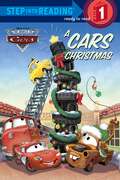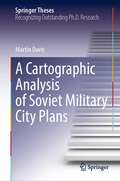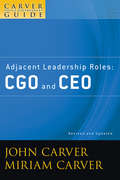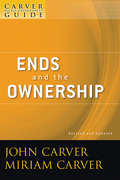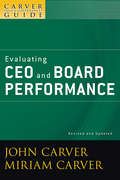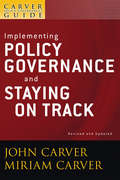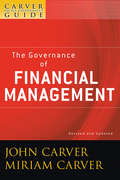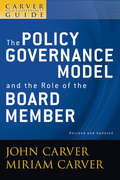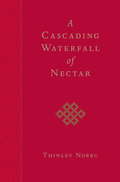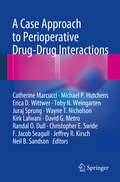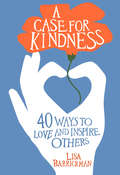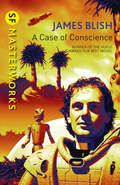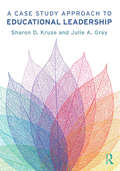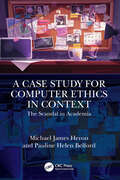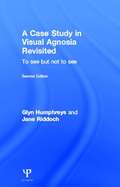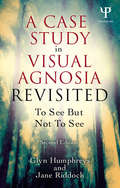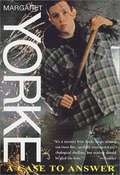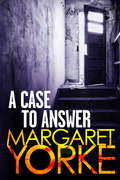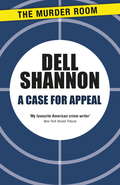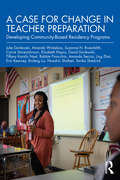- Table View
- List View
A Cars Christmas (Step into Reading)
by Melissa Lagonegro RH DisneyCelebrate the holidays with Lightning McQueen, Mater, Sally, Doc Hudson, and the rest of the cool Cars characters in this brand-new Step 1 reader.
A Cartographic Analysis of Soviet Military City Plans (Springer Theses)
by Martin DavisThe collapse of the Soviet Union has seen the emergence of its unprecedentedly comprehensive global secret military mapping project and the commercial availability of a vast number of detailed topographic maps and city plans at several scales. This thesis provides an in-depth examination of the series of over 2,000 large-scale city plans produced in secret by the Military Topographic Directorate (Военное топографическое управление) of the General Staff between the end of the Second World War and the collapse of the USSR in 1991. After positioning the series in its historical context, the nature and content of the plans are examined in detail. A poststructuralist perspective introduces possibilities to utilise and apply the maps in new contexts, which this thesis facilitates by providing a systematic, empirical analysis of the Soviet map symbology at 1:10,000 and 1:25,000, using new translations of production manuals and a sample of the city plans. A comparative analysis with the current OpenStreetMap symbology indicates scope for Soviet mapping to be used as a valuable supplementary topographic resource in a variety of existing and future global mapping initiatives, including humanitarian crisis mapping. This leads to a conclusion that the relevance and value of Soviet military maps endure in modern applications, both as a source of data and as a means of overcoming contemporary cartographic challenges relating to symbology, design and the handling of large datasets.
A Carver Policy Governance Guide, Adjacent Leadership Roles: CGO and CEO (J-B Carver Board Governance Series #42)
by John Carver Miriam Mayhew CarverThe Carver Policy Governance Guide series includes six booklets that offer board members a description of John Carver's Policy Governance model of board leadership. Policy Governance enables a board to fulfill its accountability to its organization's "owners," whether the owners are association members, city residents, company shareholders, or a community of interest. Policy Governance addresses the board's engagement in financial, programmatic, and personnel matters; roles of officers and committees; reporting and evaluation; agendas; and other aspects of the board job. For boards pursuing, or wanting to pursue, the Policy Governance model, Adjacent Leadership Roles: CGO and CEO examines the leadership roles needed in the boardroom and the executive suite. This guide reveals the two important and separate functions that are key to enabling both governance and management to have the benefit of optimal leadership. The Policy Governance model is based on the functions rather than the structure of a governing board. It outlines commonsense principles about governing that fit together into an entire system. The practices of the Policy Governance board, which are consistent with the principles, allow it to control without meddling, focus on long-term organizational outputs, powerfully delegate to a CEO and staff, and discharge its fiduciary responsibility in a visionary, strategic manner. Because the model is a total system, the Carver Policy Governance Guide series offers boards a complete set of principles for fulfilling their various obligations.
A Carver Policy Governance Guide, Ends and the Ownership (J-B Carver Board Governance Series #37)
by John Carver Miriam Mayhew Carver Carver Governance Design Inc.The Carver Policy Governance® Guide series includes six booklets that offer board members a description of John Carver's Policy Governance model of board leadership. Policy Governance enables a board to fulfill its accountability to its organization's "owners," whether the owners are association members, city residents, company shareholders, or a community of interest. Policy Governance addresses the board's engagement in financial, programmatic, and personnel matters; roles of officers and committees; reporting and evaluation; agendas; and other aspects of the board job. Ends and the Ownership helps boards distinguish between what an organization is for and what it does (ends versus means)—a basic feature of the innovative Policy Governance model. This important guide also discusses the concept of ownership and includes sample policies that can help board members effectively prioritize and govern. The Policy Governance model is based on the functions rather than the structure of a governing board. It outlines commonsense principles about governing that fit together into an entire system. The practices of the Policy Governance board, which are consistent with the principles, allow it to control without meddling, focus on long-term organizational outputs, powerfully delegate to a CEO and staff, and discharge its fiduciary responsibility in a visionary, strategic manner. Because the model is a total system, the Carver Policy Governance Guide series offers boards a complete set of principles for fulfilling their various obligations.
A Carver Policy Governance Guide, Evaluating CEO and Board Performance
by John Carver Carver Governance Design Inc. Miriam CarverThe Carver Policy Governance Guide series includes six booklets that offer board members a description of John Carver's Policy Governance model of board leadership. Policy Governance enables a board to fulfill its accountability to its organization's "owners," whether the owners are association members, city residents, company shareholders, or a community of interest. Policy Governance addresses the board's engagement in financial, programmatic, and personnel matters; roles of officers and committees; reporting and evaluation; agendas; and other aspects of the board job.Evaluating CEO and Board Performance offers board members information on the importance of evaluation as part of a greater systematic view of governance. The guide includes principles for effectively and honestly evaluating CEO and board performance.The Policy Governance model is based on the functions rather than the structure of a governing board. It outlines commonsense principles about governing that fit together into an entire system. The practices of the Policy Governance board, which are consistent with the principles, allow it to control without meddling, focus on long-term organizational outputs, powerfully delegate to a CEO and staff, and discharge its fiduciary responsibility in a visionary, strategic manner. Because the model is a total system, the Carver Policy Governance Guide series offers boards a complete set of principles for fulfilling their various obligations.
A Carver Policy Governance Guide, Implementing Policy Governance and Staying on Track (J-B Carver Board Governance Series #34)
by John Carver Miriam Mayhew CarverThe Carver Policy Governance Guide series includes six booklets that offer board members a description of John Carver's Policy Governance model of board leadership. Policy Governance enables a board to fulfill its accountability to its organization's "owners," whether the owners are association members, city residents, company shareholders, or a community of interest. Policy Governance addresses the board's engagement in financial, programmatic, and personnel matters; roles of officers and committees; reporting and evaluation; agendas; and other aspects of the board job. Implementing Policy Governance and Staying on Track shows boards how they can apply the principles of the Policy Governance model and change the way they govern in practice. The guide cuts across various aspects of the Policy Governance model and challenges board members to move from concepts to practice. The Policy Governance model is based on the functions rather than the structure of a governing board. It outlines commonsense principles about governing that fit together into an entire system. The practices of the Policy Governance board, which are consistent with the principles, allow it to control without meddling, focus on long-term organizational outputs, powerfully delegate to a CEO and staff, and discharge its fiduciary responsibility in a visionary, strategic manner. Because the model is a total system, the Carver Policy Governance Guide series offers boards a complete set of principles for fulfilling their various obligations.
A Carver Policy Governance Guide, The Governance of Financial Management (J-B Carver Board Governance Series #39)
by John Carver Miriam Mayhew CarverThe Carver Policy Governance Guide series includes six booklets that offer board members a description of John Carver's Policy Governance model of board leadership. Policy Governance enables a board to fulfill its accountability to its organization's "owners," whether the owners are association members, city residents, company shareholders, or a community of interest. Policy Governance addresses the board's engagement in financial, programmatic, and personnel matters; roles of officers and committees; reporting and evaluation; agendas; and other aspects of the board job. The Governance of Financial Management offers a proven strategic approach to the issues of finances and board responsibility. It reveals how a board can effectively govern an organization's financial planning by controlling budget values rather than budget numbers. The guide addresses the issue of actual fiscal conditions by creating policies that safeguard an organization's real fiscal health. The Policy Governance model is based on the functions rather than the structure of a governing board. It outlines commonsense principles about governing that fit together into an entire system. The practices of the Policy Governance board, which are consistent with the principles, allow it to control without meddling, focus on long-term organizational outputs, powerfully delegate to a CEO and staff, and discharge its fiduciary responsibility in a visionary, strategic manner. Because the model is a total system, the Carver Policy Governance Guide series offers boards a complete set of principles for fulfilling their various obligations.
A Carver Policy Governance Guide, The Policy Governance Model and the Role of the Board Member
by John Carver Carver Governance Design Inc. Miriam CarverThe Carver Policy Governance Guide series includes six booklets that offer board members a description of John Carver's Policy Governance model of board leadership. Policy Governance enables a board to fulfill its accountability to its organization's "owners," whether the owners are association members, city residents, company shareholders, or a community of interest. Policy Governance addresses the board's engagement in financial, programmatic, and personnel matters; roles of officers and committees; reporting and evaluation; agendas; and other aspects of the board job.The Policy Governance Model and the Role of the Board Member sets out a clear vision for excellence in board leadership. It gives board members an understanding of the concepts and principles that are at the very heart of John Carver's innovative Policy Governance model. This guide details members' main tasks and presents the guidelines needed to transform a board into an effective group that consistently leads powerfully.The Policy Governance model is based on the functions rather than the structure of a governing board. It outlines commonsense principles about governing that fit together into an entire system. The practices of the Policy Governance board, which are consistent with the principles, allow it to control without meddling, focus on long-term organizational outputs, powerfully delegate to a CEO and staff, and discharge its fiduciary responsibility in a visionary, strategic manner. Because the model is a total system, the Carver Policy Governance Guide series offers boards a complete set of principles for fulfilling their various obligations.
A Cascading Waterfall of Nectar
by Thinley NorbuLike a spontaneous cascade of wisdom nectar, the open and natural words of Thinley Norbu Rinpoche, uncomplicated by scholarly elaboration, flow here in the tradition of the direct transmissions of Buddhas and Bodhisattvas of the past. Through commentary on the Preliminary Practices (Ngöndrö) prayer from the treasure text of the great master Tragtung Düdjom Lingpa, insights into many central practices emerge in order to deepen understanding of the foundations of Vajrayana Buddhism. Also included in the book is a commentary on Tsok Khang Dechen (Assembly Palace of Great Exaltation), the root text prayer of the second Kyabje Düdjom Rinpoche, Jigdrel Yeshe Dorje.
A Case Approach to Perioperative Drug-Drug Interactions
by Jeffrey R. Kirsch Catherine Marcucci Michael P. Hutchens Erica D. Wittwer Toby N. Weingarten Juraj Sprung Wayne T. Nicholson Kirk Lalwani David G. Metro Randal O. Dull Christopher E. Swide F. Jacob Seagull Neil B. SandsonThe occurrence of deleterious or even fatal drug-drug interactions (DDIs) in the perioperative period is no longer a theoretical concern but a harrowing reality. A Case Approach to Perioperative Drug-Drug Interactions addresses the complex realm of pharmacokinetic drug interactions in an easy-to-read volume that functions as both a comprehensive clinical reference and a casebook. The book presents a summary of the core concepts of drug interactions; an organized, annotated presentation of the drug interactions most relevant to the perioperative clinician; and approximately 200 case scenarios that highlight specific drug interactions. This book fills a real void in the clinical literature and is invaluable to anesthesiologists and surgeons, as well as trainees in both specialties; intensive care staff, including physicians, physician's assistants, and nurses; and nurse practitioners who staff preoperative evaluation clinics.
A Case For Kindness: 40 Ways to Love and Inspire Others
by Lisa BarrickmanInspired by the author's fortieth birthday celebration where she committed to forty days of intentional kindness, this book shares the ripple effect that changed an entire community. In less than a year, more than 20,000 separate acts of kindness took place as others embraced the endeavour. A Case for Kindness equips you to have that same impact on the lives of your own neighbors, family, and friends. In this book, you will find forty kindness practices that easily fit the margins of your day-to-day interactions. It is a forty-day journey that will have a lasting impact on the lives of others, while enriching your own life in the process.
A Case Of Conscience (S.F. MASTERWORKS)
by James BlishFather Ramon Ruiz-Sanchez S.J., is a part of a four man scientific commission to the planet Lithia, there to study a harmonious society of aliens living on a planets which is a biologist's paradise. He soon finds himself troubled: how can these perfect beings, living in an apparent Eden, have no conception of sin or God? If such a sinless Eden has been created apart from God, then who is responsible?Winner of the Hugo Award for best novel, 1959.New introduction by Ken MacLeod.
A Case Study Approach to Educational Leadership
by Sharon D. Kruse Julie A. Gray<i>A Case Study Approach to Educational Leadership</i> takes on six core areas of school leadership—organizational vision; curriculum, instruction, and assessment; school and external community; school climate and culture; equity; and improvement, innovation, and reform. Using a case learning approach, this volume introduces salient theoretical and empirical literature in each core area and provides illustrative cases designed for individual and group analysis. Written for aspiring educational leaders, this book facilitates the discussion and reflection of individual and collective professional judgment and helps developing leaders make sense of the challenges school leaders face today.
A Case Study for Computer Ethics in Context: The Scandal in Academia
by Michael James Heron Pauline Helen BelfordAimed at addressing the difficulties associated with teaching often abstract elements of technical ethics, this book is an extended fictional case study into the complexities of technology and social structures in complex organizations. Within this case study, an accidental discovery reveals that the algorithms of Professor John Blackbriar are not quite what they were purported to be. Over the course of 14 newspaper articles, a nebula of professional malpractice and ethical compromise is revealed, ultimately destroying the career of a prominent, successful academic.The case study touches on many topics relevant to ethics and professional conduct in computer science, and on the social structures within which computer science functions. Themes range from the growing influence of generative AI to the difficulties in explaining complex technical processes to a general audience, also touching on the environmental consequences of blockchain technology and the disproportionate gender impacts of Coronavirus. Each new revelation in the case study unveils further layers of complexity and compromise, leading to new technical and social issues that need to be addressed.Directly aimed at making ethics in the digital age accessible through the use of real-world examples, this book appeals to computer science students at all levels of the educational system, as well as making an excellent accompaniment to lecturers and course convenors alike.
A Case Study in Visual Agnosia Revisited: To See But Not To See
by Glyn W. Humphreys Jane RiddochVisual agnosia is a rare but fascinating disorder of visual object recognition that can occur after a brain lesion. This book documents the case of John, who worked intensively with the authors for 26 years after acquiring visual agnosia following a stroke. It revisits John's case over twenty years after it was originally described in the book To See But Not To See, in 1987. As in the previous book, the condition is illuminated by John and his wife, Iris, in their own words.
A Case Study in Visual Agnosia Revisited: To see but not to see
by Jane Riddoch Glyn HumphreysVisual agnosia is a rare but fascinating disorder of visual object recognition that can occur after a brain lesion. This book documents the case of John, who worked intensively with the authors for 26 years after acquiring visual agnosia following a stroke. It revisits John’s case over twenty years after it was originally described in the book To See But Not To See, in 1987. As in the previous book, the condition is illuminated by John and his wife, Iris, in their own words. A Case Study in Visual Agnosia Revisited discusses John’s case in the context of research into the cognitive neuroscience of vision over the past twenty years. It shows how John’s problems in recognition can provide important insights into the way that object recognition happens in the brain, with the results obtained in studies of John’s perception being compared to emerging work from brain imaging in normal observers. The book presents a much fuller analysis of the variety of perceptual problems that John experienced, detailing not only his impaired object recognition but also his face processing, his processing of different visual features (colour, motion, depth), his ability to act on and negotiate his environment, and his reading and writing. A Case Study in Visual Agnosia Revisited will be a key reference for those concerned with understanding how vision is implemented in the brain. It will be suitable for both undergraduate students taking courses in cognitive psychology and neuropsychology, and also researchers in the cognitive neuroscience of vision. The presentation of John’s case, and the human aspects of the disorder, will also be of great interest to a general audience of lay people interested in perception.
A Case To Answer
by Margaret YorkeThe day Jerry Hunt meets Charlotte Frost is the day he decides to abandon his rebellious, criminal ways. Despite the fact that Jerry's been to prison and has vowed never to return, he continues to run a successful scam with his friend Pete in which Jerry sweet-talks a homeowner at the front door, while Pete breaks in at the back. But the day Jerry enters Charlotte's house, he sees something in her smile that makes him determined to stay clean. In many ways, Charlotte, too, would like to leave her past behind and start over. Widowed after two years of marriage to Rupert, she is faced with the distrust and suspicions of her departed husband's family. But when Rupert's troubled granddaughter, Imogen, needs a place to stay, Charlotte agrees to take her in. Jerry soon befriends Imogen, and with her help he persuades Charlotte to let him renovate her garden. As their lives become more and more entangled, lies and deceits from both their pasts begin to surface, and on a night none of them will ever forget, Charlotte disappears. A novel of subtle suspense and creeping tension, A Case to Answer is effortlessly crafted crime fiction, in which human weakness and vulnerability lead to secrets, lies and tragedy.
A Case To Answer
by Margaret YorkeJerry and Peter have been successfully conning vulnerable householders for years. But then Jerry decides to try the straight and narrow, getting an honest job in a chip shop. Once there he meets Imogen, pregnant and temporarily living with her step-grandmother, Charlotte Frost. In his new role as a good citizen - and hopeful suitor - Jerry agrees to tackle Charlotte's neglected garden.But Charlotte has her own troubled past. Recently widowed, her departed husband's family are deeply suspicious. And as her life becomes entangled with Jerry's, lies and deceits from their pasts begin to surface, until on a night none of them will ever forget, Charlotte disappears, and Jerry is the number one suspect.A novel of subtle suspense and creeping tension, A Case to Answer is effortlessly crafted crime fiction, in which human weakness and vulnerability lead to secrets, lies and tragedy.
A Case To Answer
by Margaret YorkeJerry and Peter have been successfully conning vulnerable householders for years. But then Jerry decides to try the straight and narrow, getting an honest job in a chip shop. Once there he meets Imogen, pregnant and temporarily living with her step-grandmother, Charlotte Frost. In his new role as a good citizen - and hopeful suitor - Jerry agrees to tackle Charlotte's neglected garden.But Charlotte has her own troubled past. Recently widowed, her departed husband's family are deeply suspicious. And as her life becomes entangled with Jerry's, lies and deceits from their pasts begin to surface, until on a night none of them will ever forget, Charlotte disappears, and Jerry is the number one suspect.A novel of subtle suspense and creeping tension, A Case to Answer is effortlessly crafted crime fiction, in which human weakness and vulnerability lead to secrets, lies and tragedy.
A Case for Appeal
by Dell ShannonBeautiful Nell Varney was a newcomer to Contera - and to murder.Suddenly she found herself in a strange courtroom faced with seven pairs of hate-ridden, accusing eyes. Seven witnesses had identified her as the murderer who had caused the death of two women by performing illegal abortions.Why would anyone in this strange town believe Nell was innocent? Could anyone help her? One man, a dedicated lawyer named Jesse Falkenstein, was determined to try . . .'My favourite American crime-writer' New York Herald Tribune
A Case for Appeal (Jesse Falkenstein)
by Dell ShannonBeautiful Nell Varney was a newcomer to Contera - and to murder.Suddenly she found herself in a strange courtroom faced with seven pairs of hate-ridden, accusing eyes. Seven witnesses had identified her as the murderer who had caused the death of two women by performing illegal abortions.Why would anyone in this strange town believe Nell was innocent? Could anyone help her? One man, a dedicated lawyer named Jesse Falkenstein, was determined to try . . .'My favourite American crime-writer' New York Herald Tribune
A Case for Change in Teacher Preparation: Developing Community-Based Residency Programs
by Erin Kearney Xiufeng Liu Corrie Stone-Johnson Julie Gorlewski Amanda Winkelsas Suzanne N. Rosenblith Elisabeth Etopio David Gorlewski Tiffany Karalis Noel Bobbie Finocchio Amanda Seccia Ling Zhai Nooshin Shafaei Tanika ShedrickWhy are preservice teachers often told by veteran teachers to "forget what you learned" in teacher preparation programs? Why is there a gap between pedagogical practices employed at schools and those taught at colleges and universities? And why, after evidence from countless studies, are there still so few teachers of color working in our rapidly diversifying schools? These questions are addressed in this book, which describes a reconceptualized teacher preparation program based on a teacher residency model. This model is grounded in three core beliefs: first, that teacher quality is a shared responsibility between universities and school districts; second, that all students have a right to high-quality teachers who are as racially, ethnically, and linguistically diverse as the students they teach; and third, that for education to be transformative, future educators must have the right balance of theoretical knowledge and practical experiences grounded in specific contexts. Through a combination of rich description and qualitative and quantitative program data, the authors make the case that university programs focused on the communities they serve can ensure more effective, learner-ready teachers who remain in the profession longer. By providing a detailed blueprint for program development, the contents of this book will be of value and interest to educational leaders, policy makers, and researchers.
A Case for Charpentier: Treatise on Accompaniment and Composition (Historical Performance)
by Carla E. WilliamsWho originally authored the anonymous, undated French manuscript Traité d'accompagnement et de composition? Carla E. Williams tackles this mystery while providing the first English translation of this rare manuscript, which resides in the collections of the Lilly Library at Indiana University Bloomington. A Case for Charpentier presents a side-by-side transcription and translation of the treatise along with an introduction that offers historical context. In the manuscript itself, late 17th-century and early 18th-century writers discuss principal musical elements of composition including major and minor modes, the fundamental chords of both modes, dissonances and consonances, meter, tempo, and continuo realization, as well as basse continue. While these writers have not been formally identified, Williams argues that the handwriting of one is that of composer Marc-Antoine Charpentier. By providing a full physical description of the manuscript, along with comparisons of Charpentier's other writings and his handwriting, Williams sheds new light on both the treatise and Charpentier's theoretical writings. With this translation, Williams not only shares invaluable insights into the pedagogical approaches for composition and continuo realization in late 17th-century France but also finally makes Traité d'accompagnement et de composition available to a broader audience.
A Case for Climate Engineering
by David KeithClimate engineering -- which could slow the pace of global warming by injecting reflective particles into the upper atmosphere -- has emerged in recent years as an extremely controversial technology. And for good reason: it carries unknown risks and it may undermine commitments to conserving energy. Some critics also view it as an immoral human breach of the natural world. The latter objection, David Keith argues in "A Scientist's Case for Climate Engineering," is groundless; we have been using technology to alter our environment for years. But he agrees that there are large issues at stake. A leading scientist long concerned about climate change, Keith offers no na've proposal for an easy fix to what is perhaps the most challenging question of our time; climate engineering is no silver bullet. But he argues that after decades during which very little progress has been made in reducing carbon emissions we must put this technology on the table and consider it responsibly. That doesn't mean we will deploy it, and it doesn't mean that we can abandon efforts to reduce greenhouse gas emissions. But we must understand fully what research needs to be done and how the technology might be designed and used. This book provides a clear and accessible overview of what the costs and risks might be, and how climate engineering might fit into a larger program for managing climate change.
A Case for Climate Engineering (Boston Review Books)
by David KeithA leading scientist argues that we must consider deploying climate engineering technology to slow the pace of global warming. Climate engineering—which could slow the pace of global warming by injecting reflective particles into the upper atmosphere—has emerged in recent years as an extremely controversial technology. And for good reason: it carries unknown risks and it may undermine commitments to conserving energy. Some critics also view it as an immoral human breach of the natural world. The latter objection, David Keith argues in A Scientist's Case for Climate Engineering, is groundless; we have been using technology to alter our environment for years. But he agrees that there are large issues at stake. A leading scientist long concerned about climate change, Keith offers no naïve proposal for an easy fix to what is perhaps the most challenging question of our time; climate engineering is no silver bullet. But he argues that after decades during which very little progress has been made in reducing carbon emissions we must put this technology on the table and consider it responsibly. That doesn't mean we will deploy it, and it doesn't mean that we can abandon efforts to reduce greenhouse gas emissions. But we must understand fully what research needs to be done and how the technology might be designed and used. This book provides a clear and accessible overview of what the costs and risks might be, and how climate engineering might fit into a larger program for managing climate change.
